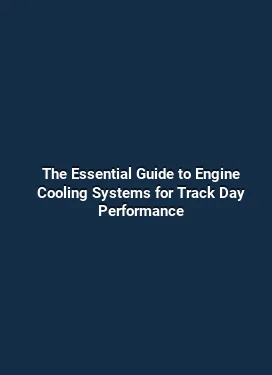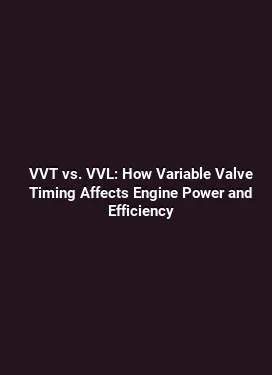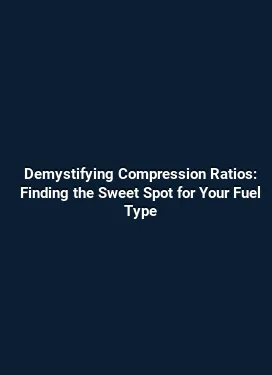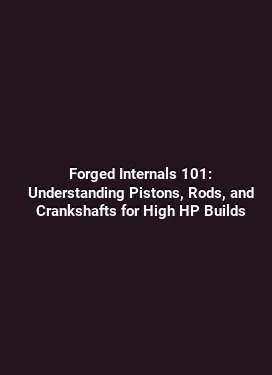The Complete Guide to Engine Bearings: Selecting the Right Clearance and Material
Engine bearings are the quiet workhorses that sustain the flow of power from the crankshaft to the rest of the engine. They must support heavy loads, maintain precise oil film separations, and withstand high temperatures and dynamic stresses. Making informed decisions about bearing material and clearance is essential for reliability, efficiency, and performance across a wide range of engines—from daily drivers to high-performance builds. This guide dives into the chemistry of bearing materials, the physics of oil clearance, and the practical steps builders use to optimize bearing life without compromising performance.
Understanding the Role of Bearings in an Internal Combustion Engine

Engine bearings primarily serve as the interface between rotating components (crankshaft, camshafts, connecting rods) and the engine block. They must allow smooth rotation while carrying radial and thrust loads. The oil film that forms between the bearing and journal is crucial: it reduces metal-to-metal contact, dissipates heat, and helps maintain a consistent oil pressure throughout the engine. Bearing clearances influence oil film thickness, hydro-dynamic pressure development, and ultimately the stability of the rotating assembly under load.
The bearing’s geometry and finish influence the formation of the oil wedge, a thin layer of oil that sustains the separation of moving surfaces at speed. If clearance is too tight, the film may fail to develop, leading to metal-on-metal contact and accelerated wear. If clearance is too loose, the oil film can become unstable, reducing lubrication efficiency and increasing fuel consumption. Precision in clearance selection is therefore a balancing act between load support, oil pressure, temperature, and engine speed.
Clearance and Load Interactions

Clearance is not a one-size-fits-all specification. It is determined by engine type, bearing type, journal diameter, and the expected operating envelope. Heavy-duty or high-load applications typically require larger clearances to accommodate higher oil demands and thermal growth. Light-duty or performance-tuned engines may use tighter clearances to maximize oil film stability and reduce parasitic drag. The interaction between clearance and engine speed—the operating window—drives the final clearance target.
In practice, manufacturers often provide bearing clearances as a range, or they specify a target centerline clearance with tolerances. During assembly, measurement methods like plastigauge, micrometry, and bore gauges help ensure that actual clearances align with the intended range. Maintaining consistent oil pressure and filtration is also critical because degraded oil quality can alter effective clearance by changing viscosity and film formation characteristics.
Materials: Bearing Alloys that Balance Load, Wear, and Damping
Bearing materials are a blend of softness and resilience designed to embed small abrasives, resist seizure, and maintain dimensional stability under heat. The most common bearing shells use copper-lead (Cu-Pb) or leaded tin alloys, sometimes with aluminum or steel backings for added stiffness and thermal properties. Modern designs may incorporate advanced copper alloys, aluminum-based materials, or composite tribological coatings to reduce friction and improve wear resistance. The choice of material affects embedding properties, conformability to a worn journal, and the ability to maintain a stable oil film under changing loads.
Standard copper-lead babbitt remains a reliable baseline for many applications due to its conformability and sacrificial nature. However, pure copper-lead can behave differently under elevated temperatures and high-load bursts. Aluminum-based bearings offer improved strength-to-weight characteristics and lower mass, which can be advantageous in performance builds where crankshaft inertia is a factor. Steel-backed shells increase rigidity and resistance to deformation, particularly in engines with high torsional loads or aggressive tuning. In some cases, surface coatings such as low-friction ceramic or polymer films are applied to reduce friction and help with break-in wear characteristics.
Choosing the Right Material for Your Application
Material selection begins with understanding the engine’s duty cycle, lubrication quality, and expected temperatures. For a typical street engine, a well-proportioned Cu-Pb bearing with a proper backing is usually sufficient, provided the oil system delivers clean, stable viscosity across operating temperatures. For high-performance or forced-induction engines, consider materials with enhanced thermal stability and improved wear resistance, such as copper alloys designed for high-temperature operation or aluminum-backed shells with compatible surface treatments.
Another consideration is the compatibility of the bearing material with the crankshaft material and journal finish. Different combinations can affect embedability (the ability of the bearing to accommodate minor imperfections without scoring) and conformability (the bearing’s ability to maintain contact with a slightly warped journal). Matching the bearing finish and oil chemistry to the chosen material is essential for predictable wear patterns and reliable engine life.
Clearance Strategies: How to Specify and Verify Oil Film Gaps
Oil clearance is the distance between the bearing surface and the crank journal when the engine is assembled and at operating temperature. Clearances are typically measured in thousandths of an inch (mils) or millimeters, and they come with tolerances to account for manufacturing variation and thermal growth. Clearances influence oil film thickness, friction, and noise. In performance engines, a small adjustment to clearance can yield meaningful gains in efficiency or durability, but misjudgments can lead to premature wear or reduced oil pressure.
Engine builders rely on a combination of manufacturer specifications, empirical experience, and precise measurement techniques to determine the ideal clearance. Plastigauge tests, micrometers, dial bore gauges, and in some cases, bore-scanner measurements are used to confirm that the actual clearances fall within the target window. Temperature compensation is also important: clearance measured at room temperature will change as the engine reaches operating temperatures due to thermal expansion of the block, the bearing material, and the journal.
Practical Steps for Clearance Verification
1) Pre-assembly checks: Inspect journals for scoring or wear and ensure the rod and main bearings are correctly oriented with the engravings aligned to the block. 2) Plastigauge check: Install plastigauge along the journal, reinstall the cap, torque to spec, and disassemble to measure the compressed width. Compare it to the manufacturer’s clearance chart. 3) Micrometer and bore gauge checks: Use a micrometer to measure the bearing bore diameter and a dial bore gauge to confirm journal diameters across multiple positions. 4) Final assembly checks: After assembly and initial startup, monitor oil pressure and temperature to ensure the oil film forms correctly under load, adjusting clearances in future builds if necessary.
Installation Practices: Achieving Consistent Oil Film and Minimizing Damage
Proper installation is as important as the choice of material and clearance. Bearings must seat evenly, caps must be torqued in a uniform, crisscross pattern, and lubricants should be chosen to support the bearing material and oil system design. A smooth, consistent journal finish, clean surfaces, and correct alignment all contribute to predictable oil film formation and long-term reliability. Poor installation can cause edge wear, micro-pitting, or bearing tilt that disrupts the oil wedge and accelerates wear.
Surface finish and journal geometry play a critical role. A rough or out-of-spec journal surface can grab the bearing edge, leading to scuffing at startup or under high-load transitions. Conversely, an excessively smooth finish may reduce the bearing’s ability to embed minor debris, increasing the risk of scoring. The goal is to achieve a balanced finish that promotes stable oil film formation while allowing the bearing to conform to journal imperfections without compromising load support.
Lubrication System Considerations
The lubrication system must deliver clean, steady oil with sufficient pressure across the operating range. Cold starts demand quick oil film formation, while hot runs require that the oil remains viscous enough to sustain the film without excessive thermal thinning. Filtration, oil viscosity, and pump capability all influence how well the chosen clearances and materials perform in real-world conditions. In performance contexts, engineers may optimize oil channels and gallery flow to support targeted bearing loads and reduce pressure pulsations that can destabilize the oil film.
Wear, Diagnostics, and Maintenance: Interpreting Bearing Health
Bearings are designed to wear gradually in a controlled manner, but rapid changes in wear rate signal potential issues in oil quality, clearance, or lubrication delivery. Diagnostics such as oil analysis, bearing wear comments from torn-down engines, and thermal imaging during startup can reveal early signs of trouble. Common indicators include abnormal noise, fluctuating oil pressure, or changes in crankcase temperature distribution. Interventions may involve rechecking clearances, reconditioning journals, or upgrading bearing materials to better withstand the engine’s operating conditions.
Responsive maintenance extends bearing life. Teams that routinely scan oil samples for metal particles, monitor oil viscosity across temperature ranges, and verify pump and filter performance are better equipped to sustain reliability, particularly in high-mileage or high-stress applications. A disciplined approach to inspections helps detect wear trends before they lead to major failures, enabling targeted adjustments to clearances, lubrication strategy, or cooling capacity.
Performance Considerations: Tuning for Power, Efficiency, and Longevity
Performance tuning often requires a nuanced balance between friction, oil consumption, and load capacity. Slightly tighter clearances can reduce parasitic drag and improve throttle response, but they demand high-quality oil and impeccable manufacturing control to avoid scuffing. Conversely, slightly looser clearances can improve reliability under high load and temperature spikes, at the cost of marginal efficiency losses. The choice of material interacts with these decisions; more conformable materials can tolerate minor journal imperfections, while stiffer materials may improve control over oil film stability under aggressive throttle and high RPM scenarios.
In modern engines, the interplay between bearing design and lubrication strategy is increasingly sophisticated. Modern oils with advanced viscosity modifiers, better oxidation resistance, and improved shear stability enable closer clearances without compromising protection. Engine builders who align bearing selection with the oil system’s capabilities can achieve a blend of strong performance, durability, and predictable maintenance intervals.
Case Study: From Stock to High-Performance
A stock engine with Cu-Pb bearings and standard clearances can achieve solid reliability with proper oil quality and regular maintenance. Upgrading to aluminum-backed bearing shells on a high-revving performance build, combined with a tuned oil system and precise clearance targeting, can yield improved main and rod bearing stability, reduced drag, and a stronger, more consistent oil film at temperature. The key is to revalidate clearances and journal finish after any significant modification, ensuring compatibility with the chosen oil and thermal loads.
Ultimately, success hinges on aligning material choice, clearance strategy, lubrication, and assembly practices with the engine’s intended duty cycle. Documentation of measurements, adherence to tolerances, and attention to break-in procedures all contribute to predictable, durable power delivery across a wide range of operating conditions.






